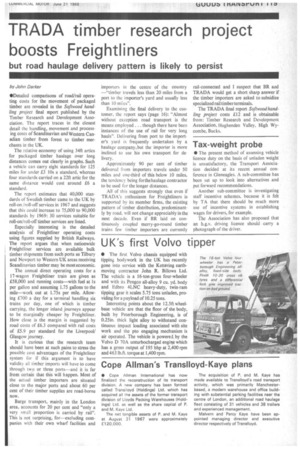TRADA timber research project boosts Freightliners
Page 121

If you've noticed an error in this article please click here to report it so we can fix it.
but road haulage delivery pattern is likely to persist
by John Darker • Detailed comparisons of road/rail operating costs for the movement of packaged timber are revealed in the Softwood handling project final 'wort published by the Timber Research and Development Association. The report traces in the closest detail the handling, movement and processing costs of Scandinavian and Western Canadian timber from forest to timber merchants in the UK.
The relative economy of using 34ft artics for packaged timber haulage over long distances comes out clearly in graphs. Such a vehicle can carry eight standards for 125 miles for under £3 lOs a standard, whereas four standards carried on a 22ft attic for the same distance would cost around £6 a standard.
The report estimates that 40,000 standards of Swedish timber came.to the UK by roll-on /roll-off services in 1967 and suggests that this could increase to 75,000 to 90,000 standards by 1969: 30 services suitable for roll-on/roll-off timber services are listed.
Especially interesting is the detailed• analysis of Freightliner operating costs using figures supplied by British Railways. The report argues that when nationwide Freightliner services are available bulk timber shipments from such ports as Tilbury and Newport to Western UK areas receiving Scandinavian timber may he most economic.
The annual direct operating costs for a 17-wagon Freightliner train are given as £58,000 and running costs—with fuel at is per gallon and assuming 1.75 gallons to the mile—work out at 1.75s per mile. Allowing £700 a day for a terminal handling six trains per day, one of which is timber carrying, the longer inland journeys appear to be marginally cheaper by Freightliner. How close is the margin is suggested by road costs of £6.3 compared with rail costs of £5.9 per standard for the Liverpool/ Glasgow journey.
It is curious that the research team should have been at such pains to stress the possible cost advantages of the Freightliner system for if this argument is to have validity all timber imports will have to come through two or three ports—and it is far from certain that this will happen. Most of the actual timber importers are situated close to the major ports and about 60 per cent of their timber supplies are road-borne now.
Barge transport, mainly in the London area, accounts for 20 per cent and "only a very small proportion is carried by rail". This is not surprising, for—excluding companies with their own wharf facilities and importers in the centre of the country —"timber travels less than 20 miles from a port to the importer's yard and usually less than 10 miles".
Examining the final delivery to the customer, the report says (page 16): "Almost without exception road transport is the means employed . . though there have been instances of the use of rail for very long hauls". Delivering from port to the importer's yard is frequently undertaken by a haulage company,but the importer is more inclined to use his own transport for delivery.
Approximately 90 per cent of timber delivered from importers travels under 50 miles and one-third of this below 10 miles, the tendency being forthehaulage contractor to be used for the longer distances.
All of this suggests strongly that even if TRADA's enthusiasm for Freightliners is supported by its member firms, the existing pattern of timber distribution, predominantly by road, will not change appreciably in the next decade. Even if BR laid on continuously coupled merry-go-round timber trains few timber importers are currently rail-connected and I suspect that BR and TRADA would get a short sharp answer if the timber importers are asked to subsidize specialized rail timber terminals.
The TRADA final report Softwood handling project costs £12 and is obtainable from: Timber Research and Development Association, Hughenden Valley, High Wycombe, Bucks.








































































































































































































